"This is one of the largest river restoration projects in the western U.S.," says Bill Armstrong, the Quinault Indian Nation Habitat Management Scientist and Lead Entity Coordinator for the project. "It's a very large, very complex project."
Known for its prized blueback (sockeye) salmon run that might have numbered over a million fish on a peak year, the Quinault River has for millenia been a culturally and economically significant fishery for peoples of the modern-day Quinault Indian Nation (QIN). With glaciers melting that feed the river, water temperatures rising, previous old growth logging along the river, and large wood removal from the river (among other issues), Quinault River salmon have been rapidly declining since the 1950s.
In 2005, a scientific investigation of the river by the QIN concluded that intervention would be needed to rehabilitate the river, floodplain, forests, and salmon habitat. According to QIN President Fawn Sharp, who spoke at a public meeting at Lake Quinault Lodge last week, "We need collaborative intervention."
Fortunately, a team of scientists, engineers, and even loggers are now collaborating to restore the upper Quinault River, based on innovative concepts laid out in the QIN's 2008 Upper Quinault River Salmon Habitat Restoration Plan.
Without going into too much detail, most of the former 55 miles of extensive side sloughs and channels where salmon spawn have disappeared since the mature conifers were logged along the river. Without large trees falling into the river to divert the river into side channels, the mostly cobbled, barren floodplain provides little refuge for salmon and the river moves across the floodplain, eroding the riverbanks.
 |
| North Slough, one of the few remaining side channels in the upper Quinault River. |
 |
| Two engineered logjams on the upper Quinault River. |
Before the meeting last week, I spent a day in the field with Kevin and his fellow scientist Michael Mazzacavallo while they conducted scientific monitoring of recent Sitka spruce plantings on the upper river floodplain. For this word geek whose work involves sitting most of the day in an office, it was a refreshing change of pace, despite the bug bites, heat, and wet feet from wading through the river and side channels.
 |
| Trying to keep up with the scientists while making our way to a monitoring site. |
 |
| Map of floodplain showing different floodplain forest restoration treatment approaches and monitoring locations. |
 |
| Michael Mazzacavallo and Dr. Kevin Fetherston discuss and log site data. |
In addition, "We're not just monitoring, we're getting more data to answer more questions,” Kevin told me, such as how the seedlings grow under different conditions at each site. They're installing permanent markers in the ground at each site that will allow others to gather the same data 100 years into the future.
 |
| Sitka spruce seedling, doing well so far. |
"Is there something I can do to help?" As long as I was there, I figured I might as well make myself useful. Michael handed me eight thin metal stakes topped with a white flag and asked me to find and mark eight seedlings within about a 15-foot radius of the monitoring site marker. It was like a Where's Waldo game in the thick underbrush.
In the afternoon we were joined by Debbie Preston, Information and Education Officer of the Northwest Indian Fisheries Commission, who has followed and written about this project since its inception. Mid-afternoon when the wind picked up and branches occasionally crashed to the ground around us, Kevin decided it was time to pack it in for the day.
A good crowd from the surrounding communities gathered in the evening at Lake Quinault Lodge for an update on the project, hosted by the QIN. President Fawn Sharp spoke for a few minutes to start, and her enthusiasm and concern for restoring the upper Quinault River are evident. In turn, several of the key scientists, including Lead Entity Coordinator Bill Armstrong, Leif Embertson who designed the logjams, Dr. Kevin Fetherston, and Dr. Brian Winter, gave status updates on the various project components.
 |
| Dr. Kevin Fetherston discusses floodplain forest restoration at a community meeting. |
What's evident to me as an outsider is that several years in, the local community seems pretty much behind this program. One man voiced frustration that restoration on Finley Creek, a tributary to the Quinault River, hasn't begun as quickly as the upper Quinault restoration.
But in reality, although things are happening now on the upper Quinault, this is a very long-term project (possibly up to 50 years), with ongoing efforts by the QIN to secure state, federal, private, and tribal funding. Even 100 years from now the upper Quinault River restoration will still be in progress, albeit naturally.
Restoring the river that produced "arguably the single most famous salmon run on the Pacific coast of North America," according to author Bruce Brown in his powerful book Mountain in the Clouds, will take time. Many trees that formerly anchored the floodplain were hundreds of years old, some possibly as big as the tree pictured below just a few miles downriver on Lake Quinault.
 | |
| One of the two world's largest Sitka spruce, on the shore of Lake Quinault. |
I'm heartened that the QIN is looking ahead and leading this effort now, with climate change concerns looming for salmon. I wish I could live to see big older conifers growing again along the river. But I'm glad to know that they will be there in the centuries ahead.
For more information on the Upper Quinault River Restoration, check the Northwest Indian Fisheries Commission newsletter or the Quinault Indian Nation website. If you'd like to support this project, think about donating to some of the nonprofits who are project partners: Pacific Coast Salmon Coalition, The Nature Conservancy, and Trout Unlimited.











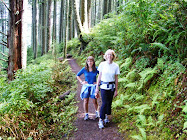

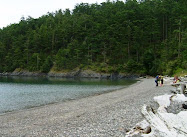
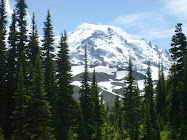



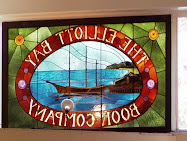

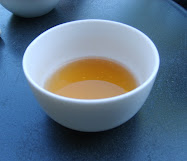
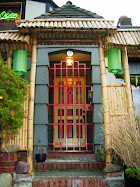




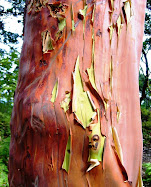

3 comments:
Thanks for going there and helping and then going to the meeting and writing the great report with pictures. I am sure the hundreds and hundreds of professionals and volunteers who are out doing this sort of thing daily all over the Pacific NW really appreciate seeing it reported and the great public support too.
Thanks for your comment and feedback Rabbit's Guy! Really appreciate it. Yes, many many people around the region are out there doing great work in the field and in offices as well in support of our ecosystems/habitats, etc.
There is simply nothing better than a river. I have been tracking dam removal for several years and each dam down and each river restoration in progress is a exercise in restoring quality to life. This one is a wonderful example of our attempts to "fix" what never needed to be fixed in the first place. We can reverse these nasty messy mistakes and make these treasures sing, as river do. And, of course, I really, really love to eat fish. Mary Lou
Post a Comment